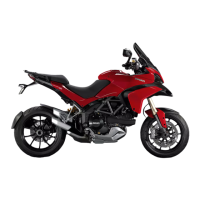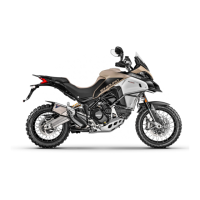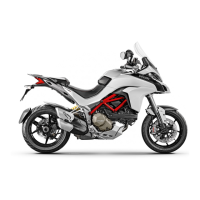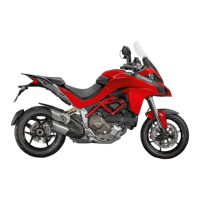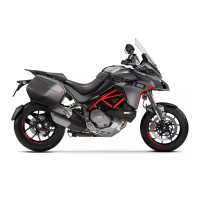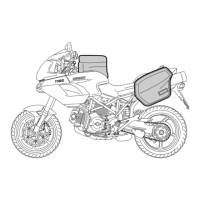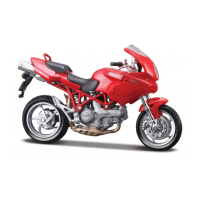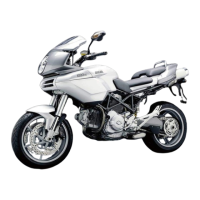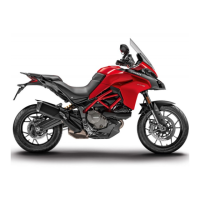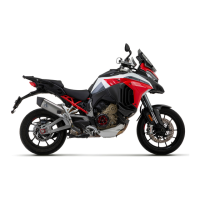Do you have a question about the Ducati Multistrada 1200 2016 and is the answer not in the manual?
General safety advice for riders and passengers, emphasizing responsibility and following manual guidelines.
Details maximum permitted weight for the motorcycle and its accessories like panniers and top cases.
Emphasizes legal requirements for licensing and avoiding riding under the influence of alcohol or drugs.
Advises checking state laws for insurance coverage and mandatory helmet use for rider and passenger safety.
Stresses the significance of proper riding gear for safety, listing essential items like helmet, gloves, jacket, and trousers.
Advises familiarizing with controls and performing recommended checks before each ride to prevent damage and injury.
Warns against starting the engine indoors due to poisonous exhaust gases, recommending outdoor or ventilated areas.
Details safety measures during refuelling, including engine off, no smoking, avoiding spills, and proper ventilation.
Specifies compatibility with E10 fuel and warns against using fuel with over 10% ethanol due to potential damage.
Outlines limits for speed with accessories fitted (panniers, top case, tank bag) and total motorcycle weight.
Warns about explosive battery gases, sparks, naked flames, and the need for proper ventilation when charging.
Describes the engine oil pressure warning light and advises stopping the engine if it remains ON.
Details the meaning of the DTC/DWC warning light based on speed, system status, and faults.
Explains the MIL (Engine Diagnosis) and ABS warning lights, their functions, and indications for system status or faults.
Explains how the panel displays active DTC status, intervention levels, and degraded operation due to faults.
Describes indications for DTC disabled status ('-') and system faults (flashing lettering).
Details how DTC faults or Black Box faults are indicated, including flashing lettering and steady warning light.
Provides a table detailing DTC intervention levels (OFF to 8), their use, and default settings for various riding modes.
Lists three main variables influencing DTC level choice: grip conditions, track/path characteristics, and riding style.
Explains how the panel indicates ABS status (active, degraded operation) with messages and flashing.
Describes indications for ABS disabled status ('-') and system faults (flashing lettering).
Details how ABS prevents wheel lockup, preserves traction, and offers combined braking and cornering functions.
Presents a table of ABS intervention levels (OFF to 3), their characteristics, and default settings for riding modes.
Explains DWC status indications: active levels, degraded operation due to faults, and disabled status.
Details how DWC faults are indicated and warns about the rider's responsibility with DWC system usage.
Provides a table of DWC intervention levels (OFF to 8), their use, and default settings for riding modes.
Lists rider experience and track/path characteristics as key factors for choosing the correct DWC level.
Explains how to activate, set target speed, increase/decrease speed, and resume previous speed using buttons (6) and (7).
Lists conditions for enabling Cruise Control: gear, speed range, and brake application after key-on.
Details methods for deactivating Cruise Control: decelerating, pressing ON/OFF button (5), or brake application.
Informs the user when the motorcycle is due for service and must be taken to a Ducati Authorised Service Centre.
Explains the 'NO KEY' warning indicating the Hands Free system does not detect the active key near the vehicle.
Details the warning for a low battery level in the Hands Free key, recommending prompt replacement.
Describes how the panel manages error warnings, turning on MIL or Generic Error lights, and advises contacting a dealer.
Warns that parameter changes should only be made by experts and suggests using 'DEFAULT' to restore factory settings.
Explains the procedure to save parameter settings for Riding Modes, including WAIT and MEM.OK indications.
Describes how to restore default values for parameters associated with a specific riding mode (DEFAULT).
Explains how to restore default values for all parameters across all riding modes (ALL DEFAULT).
Details the procedure for activating and entering a new PIN CODE, including digit entry and confirmation.
Explains how to memorize the entered PIN and when the PIN code menu page becomes unavailable.
Outlines steps to change an existing PIN CODE, including entering the old PIN and then the new PIN.
Details the process of entering the new PIN digits using buttons (2) and (1), and confirming with button (4).
Describes confirmation of PIN digits and indications for correct (OK) or incorrect (ERR) PIN entry.
Explains how to activate the hazard function for emergency signaling and its priority over single indicators.
Details the procedure for engaging the steering lock within 60 seconds of engine stop, including button presses and messages.
Explains the engine electronic block system (IMMOBILIZER) for anti-theft protection, activated by key acknowledgement.
Describes the active and passive keys, their functions, and button operations for key-on/off.
Warns against riding with keys inserted in locks, potential damage from weather, or washing.
Provides step-by-step instructions for removing and replacing the battery in the active key, including polarity.
Describes how to use the PIN code to temporarily restore motorcycle operation in case of key acknowledgement system malfunction.
Details the process of entering PIN code digits and confirming them for vehicle start after a malfunction.
Explains indications for correct (OK) or incorrect (WRONG) PIN entry and enabling vehicle start.
Identifies the location and function of key controls: instrument panel, switches, levers, pedals, and throttle.
Details procedures for turning the Hands Free system and onboard devices Key-On and Key-Off using switches or buttons.
Explains Key-On/Off using handlebar button with active/passive keys and pin code.
Explains the functions of the right-hand switch: engine stop, start, and heated handgrips control.
Provides instructions on using the side stand, including parking precautions and operation checks.
Provides recommendations for the running-in period, including engine speed limits, brake usage, and ideal riding conditions.
Lists critical checks for fuel, oil, fluids, tyres, controls, lights, locks, and stand before riding.
Explains the ON and OFF behavior of the ABS light indicator relative to motorcycle speed, indicating correct operation.
Warns to contact a Ducati Dealer or Service Centre in case of ABS malfunction.
Advises checking and cleaning the front and rear phonic wheels for proper ABS operation.
Emphasizes familiarization with controls and warns against indoor engine operation due to exhaust gases.
Details the Key-On procedure using the red switch and button, and system initialization sequence.
Explains how to start the engine, including side stand sensor function and clutch lever use.
Guides on starting to move by disengaging clutch, engaging first gear, and accelerating.
Advises on proper braking techniques, including avoiding sudden inputs and gentle braking in adverse conditions.
Details steps for stopping the motorcycle, shifting to neutral, applying brakes, and turning off the engine.
Explains how to engage the steering lock within 60 seconds of engine stop, including button presses and messages.
Specifies compatible fuel types, minimum octane, and ethanol content limits, with warranty void warnings.
Guides on checking coolant level in the expansion reservoir and topping up with specific antifreeze.
Explains how to check brake and clutch fluid levels and recommends fluid changes every four years.
Details how to check brake pad wear through inspection holes and when replacement is needed.
Outlines steps for removing the battery and connecting a charger, emphasizing safety precautions.
Explains how to check drive chain tension, specifying the correct measurement method and range.
Describes how to check and adjust headlight aiming for correct beam height and alignment.
Lists recommended front and rear tyre pressures for rider only and with passenger/bags.
Advises on tyre repair, replacement, valve cap tightening, and wheel balancing.
Guides on checking engine oil level via the sight glass and topping up with recommended oil.
Provides a detailed schedule of operations for dealers based on mileage (km/mi) and time intervals (months).
Lists basic maintenance tasks for the customer: checking engine oil, brake fluid, tyre pressure, chain tension, and brake pads.
Lists overall weight, weight without fluids, maximum allowed weight, and speed limits with accessories.
Details fuel type, oil recommendations, brake/clutch fluids, coolant specifications, and capacities.
Lists engine details: type, bore, stroke, displacement, compression ratio, power, torque, and maximum RPM.
Provides technical data for front/rear brakes, clutch, gearbox, and drive chain specifications.
Lists tyre sizes, makes, suspension types, wheel travel, and frame details.
General safety advice for riders and passengers, emphasizing responsibility and following manual guidelines.
Details maximum permitted weight for the motorcycle and its accessories like panniers and top cases.
Emphasizes legal requirements for licensing and avoiding riding under the influence of alcohol or drugs.
Advises checking state laws for insurance coverage and mandatory helmet use for rider and passenger safety.
Stresses the significance of proper riding gear for safety, listing essential items like helmet, gloves, jacket, and trousers.
Advises familiarizing with controls and performing recommended checks before each ride to prevent damage and injury.
Warns against starting the engine indoors due to poisonous exhaust gases, recommending outdoor or ventilated areas.
Details safety measures during refuelling, including engine off, no smoking, avoiding spills, and proper ventilation.
Specifies compatibility with E10 fuel and warns against using fuel with over 10% ethanol due to potential damage.
Outlines limits for speed with accessories fitted (panniers, top case, tank bag) and total motorcycle weight.
Warns about explosive battery gases, sparks, naked flames, and the need for proper ventilation when charging.
Describes the engine oil pressure warning light and advises stopping the engine if it remains ON.
Details the meaning of the DTC/DWC warning light based on speed, system status, and faults.
Explains the MIL (Engine Diagnosis) and ABS warning lights, their functions, and indications for system status or faults.
Explains how the panel displays active DTC status, intervention levels, and degraded operation due to faults.
Describes indications for DTC disabled status ('-') and system faults (flashing lettering).
Details how DTC faults or Black Box faults are indicated, including flashing lettering and steady warning light.
Provides a table detailing DTC intervention levels (OFF to 8), their use, and default settings for various riding modes.
Lists three main variables influencing DTC level choice: grip conditions, track/path characteristics, and riding style.
Explains how the panel indicates ABS status (active, degraded operation) with messages and flashing.
Describes indications for ABS disabled status ('-') and system faults (flashing lettering).
Details how ABS prevents wheel lockup, preserves traction, and offers combined braking and cornering functions.
Presents a table of ABS intervention levels (OFF to 3), their characteristics, and default settings for riding modes.
Explains DWC status indications: active levels, degraded operation due to faults, and disabled status.
Details how DWC faults are indicated and warns about the rider's responsibility with DWC system usage.
Provides a table of DWC intervention levels (OFF to 8), their use, and default settings for riding modes.
Lists rider experience and track/path characteristics as key factors for choosing the correct DWC level.
Explains how to activate, set target speed, increase/decrease speed, and resume previous speed using buttons (6) and (7).
Lists conditions for enabling Cruise Control: gear, speed range, and brake application after key-on.
Details methods for deactivating Cruise Control: decelerating, pressing ON/OFF button (5), or brake application.
Informs the user when the motorcycle is due for service and must be taken to a Ducati Authorised Service Centre.
Explains the 'NO KEY' warning indicating the Hands Free system does not detect the active key near the vehicle.
Details the warning for a low battery level in the Hands Free key, recommending prompt replacement.
Describes how the panel manages error warnings, turning on MIL or Generic Error lights, and advises contacting a dealer.
Warns that parameter changes should only be made by experts and suggests using 'DEFAULT' to restore factory settings.
Explains the procedure to save parameter settings for Riding Modes, including WAIT and MEM.OK indications.
Describes how to restore default values for parameters associated with a specific riding mode (DEFAULT).
Explains how to restore default values for all parameters across all riding modes (ALL DEFAULT).
Details the procedure for activating and entering a new PIN CODE, including digit entry and confirmation.
Explains how to memorize the entered PIN and when the PIN code menu page becomes unavailable.
Outlines steps to change an existing PIN CODE, including entering the old PIN and then the new PIN.
Details the process of entering the new PIN digits using buttons (2) and (1), and confirming with button (4).
Describes confirmation of PIN digits and indications for correct (OK) or incorrect (ERR) PIN entry.
Explains how to activate the hazard function for emergency signaling and its priority over single indicators.
Details the procedure for engaging the steering lock within 60 seconds of engine stop, including button presses and messages.
Explains the engine electronic block system (IMMOBILIZER) for anti-theft protection, activated by key acknowledgement.
Describes the active and passive keys, their functions, and button operations for key-on/off.
Warns against riding with keys inserted in locks, potential damage from weather, or washing.
Provides step-by-step instructions for removing and replacing the battery in the active key, including polarity.
Describes how to use the PIN code to temporarily restore motorcycle operation in case of key acknowledgement system malfunction.
Details the process of entering PIN code digits and confirming them for vehicle start after a malfunction.
Explains indications for correct (OK) or incorrect (WRONG) PIN entry and enabling vehicle start.
Identifies the location and function of key controls: instrument panel, switches, levers, pedals, and throttle.
Details procedures for turning the Hands Free system and onboard devices Key-On and Key-Off using switches or buttons.
Explains Key-On/Off using handlebar button with active/passive keys and pin code.
Explains the functions of the right-hand switch: engine stop, start, and heated handgrips control.
Provides instructions on using the side stand, including parking precautions and operation checks.
Provides recommendations for the running-in period, including engine speed limits, brake usage, and ideal riding conditions.
Lists critical checks for fuel, oil, fluids, tyres, controls, lights, locks, and stand before riding.
Explains the ON and OFF behavior of the ABS light indicator relative to motorcycle speed, indicating correct operation.
Warns to contact a Ducati Dealer or Service Centre in case of ABS malfunction.
Advises checking and cleaning the front and rear phonic wheels for proper ABS operation.
Emphasizes familiarization with controls and warns against indoor engine operation due to exhaust gases.
Details the Key-On procedure using the red switch and button, and system initialization sequence.
Explains how to start the engine, including side stand sensor function and clutch lever use.
Guides on starting to move by disengaging clutch, engaging first gear, and accelerating.
Advises on proper braking techniques, including avoiding sudden inputs and gentle braking in adverse conditions.
Details steps for stopping the motorcycle, shifting to neutral, applying brakes, and turning off the engine.
Explains how to engage the steering lock within 60 seconds of engine stop, including button presses and messages.
Specifies compatible fuel types, minimum octane, and ethanol content limits, with warranty void warnings.
Guides on checking coolant level in the expansion reservoir and topping up with specific antifreeze.
Explains how to check brake and clutch fluid levels and recommends fluid changes every four years.
Details how to check brake pad wear through inspection holes and when replacement is needed.
Outlines steps for removing the battery and connecting a charger, emphasizing safety precautions.
Explains how to check drive chain tension, specifying the correct measurement method and range.
Describes how to check and adjust headlight aiming for correct beam height and alignment.
Lists recommended front and rear tyre pressures for rider only and with passenger/bags.
Advises on tyre repair, replacement, valve cap tightening, and wheel balancing.
Guides on checking engine oil level via the sight glass and topping up with recommended oil.
Provides a detailed schedule of operations for dealers based on mileage (km/mi) and time intervals (months).
Lists basic maintenance tasks for the customer: checking engine oil, brake fluid, tyre pressure, chain tension, and brake pads.
Lists overall weight, weight without fluids, maximum allowed weight, and speed limits with accessories.
Details fuel type, oil recommendations, brake/clutch fluids, coolant specifications, and capacities.
Lists engine details: type, bore, stroke, displacement, compression ratio, power, torque, and maximum RPM.
Provides technical data for front/rear brakes, clutch, gearbox, and drive chain specifications.
Lists tyre sizes, makes, suspension types, wheel travel, and frame details.
| Torque | 136 Nm (100.3 lb-ft) @ 7, 500 rpm |
|---|---|
| Transmission | 6-speed |
| Frame | Tubular steel Trellis frame |
| Wheelbase | 1, 529 mm (60.2 in) |
| ABS | Standard |
| Traction Control | Ducati Traction Control (DTC) |
| Riding Modes | Sport, Touring, Urban, Enduro |
| Engine Type | L-twin, 4 valves per cylinder, Desmodromic, liquid cooled |
| Power | 160 hp (117.7 kW) @ 9, 500 rpm |
| Fuel Injection | Bosch electronic fuel injection system, elliptical throttle bodies |
| Front Suspension | 48 mm fully adjustable USD fork |
| Rear Suspension | Fully adjustable monoshock |
| Front Brake | 2 x 320 mm semi-floating discs, radially mounted Brembo monobloc 4-piston |
| Rear Brake | 245mm disc, 2-piston caliper |
| Dry Weight | 209 kg |
| Seat Height | Adjustable 825 - 845 mm (32.5 - 33.3 in) |
| Fuel Tank Capacity | 20 litres (5.3 US gal) |
